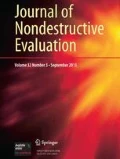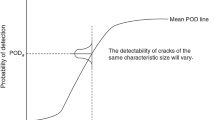Abstract
We investigate the problem of detecting and assessing, by means of static electrical measurements, damage due to corrosion in a structure. Corrosion damage, which is assumed to occur in an inaccessible part of a specimen, is modelled as material loss. The detection device consists of electrodes which inject DC current and measure voltage potentials in the accessible part of the specimen. The topography of the damaged surface is estimated from the measured data. This research is meant to evaluate if a method based on static electrical measurements has the potential to be developed into a useful nondestructive evaluation tool. We propose computational methods that take the measured data and estimate the unknown damaged surface. The methods are studied in order to understand their properties. Several example calculations from synthetic data are presented. Our findings indicate that such a device has limited resolution. However, it offers several advantages that make it worthwhile to pursue further research.
Similar content being viewed by others
References
S. Andrieux, A. Ben Abda, and M. Jaoua, Identifiabilité de frontière inaccessible par des mesures de surface,C. R. Acad. Sci. Paris 316–1:429–434 (1993).
D. Barber and B. Brown, Recent developments in applied potential tomography-APT, inInformation Processing in Medical Imaging, S. Bacharach, ed. (1986), pp. 106–121.
D. Dobson and F. Santosa, Resolution and stability analysis of an inverse problem in electrical impedance imaging-dependence on the input current patterns.SIAM J. Appl. Math. 54:1542–1560 (1994).
I. Hall, personal communication (1994–95).
R. Halmshaw,Non-destructive Testing (Wiley-Interscience, 1987).
D. Isaacson, Distinguishability of conductivities by electric current computed tomography,IEEE Trans. Med. Imag. MI-5:91–95 (1986).
P. Kaup, F. Santosa, and M. Vogelius, Imaging corrosion damage in a thin plate by electrostatic measurement (in press).
V. Liepa, F. Santosa, and M. Vogelius, Crack determination from boundary measurements-reconstruction from experimental data,J. Nondestr. Eval. 53:163–174 (1993).
A. Sezginer, Time-Lapse Gravity: Imaging Density Changes, Talk presented at University of Delaware, May (1994).
C. Chiang, ed.,Second Airforce Aging Aircraft Conference (Tinker AFB, OK, May 1994).
K. Bryan and L. Candill, An inverse problem in thermal imaging, Preprint 1994.
Author information
Authors and Affiliations
Rights and permissions
About this article
Cite this article
Kaup, P.G., Santosa, F. Nondestructive evaluation of corrosion damage using electrostatic measurements. J Nondestruct Eval 14, 127–136 (1995). https://doi.org/10.1007/BF01183118
Received:
Revised:
Issue Date:
DOI: https://doi.org/10.1007/BF01183118




